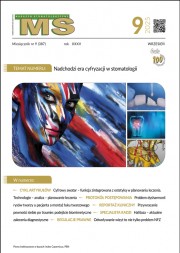Dostęp do tego artykułu jest płatny.
Zapraszamy do zakupu!
Po dokonaniu zakupu artykuł w postaci pliku PDF prześlemy bezpośrednio pod twój adres e-mail.
STUDIA PRZYPADKÓW
Ewolucja materiałów bioaktywnych – ich zastosowanie od endodoncji po protetykę
Evolution of bioactive materials – their application from endodontics to prosthodontics
Łukasz Balcerzak, Marta Smolińska
Streszczenie
W artykule opisano dwa przypadki leczenia endodontycznego, w których zostały użyte materiały bioaktywne, począwszy od zastosowania ich w endodoncji i kontrolę przebiegu gojenia zmian okołowierzchołkowych, poprzez odbudowę rdzenia zęba, kończąc na cementowaniu korony.
Abstract
The article describes two cases of endodontic treatment in which bioactive materials were used, starting from their use in endodontics and monitoring the healing process of periapical lesions, through the reconstruction of the tooth core, ending with cementation of the crown.
Hasła indeksowe: materiały bioaktywne, leczenie endodontyczne
Key words: bioactive materials, endodontic treatment
Piśmiennictwo
- Siqueira JF, de Uzeda M. Influence of different vehicles on the antibacterial effects of calcium hydroxide. J Endod. 1998; 24(10):663-665.
- Orstavik D, Kerekes K, Molven O. Effects of extensive apical reaming and calcium hydroxide dressing on bacterial infection during treatment of apical periodontitis: a pilot study. Int Endod J. 1991; 24(1): 1-7.
- Walton RE, Holton IF, Michelich R. Calcium hydroxide as an intracanal medication: effect on post treatment pain. J Endod. 2003; 29(10): 627-629.
- Tamse A, Ben-Amar A, Gover A. Sealing properties of temporary filling materials used in endodontics. J Endod. 1982; 8(7): 322-325.
- Andreasen JO, Munksgaard EC, Bakland LK. Comparison of fracture resistance in root canals of immature sheep teeth after filling with calcium hydroxide or MTA. Dent Traumatol. 2006; 22(3): 154-156.














